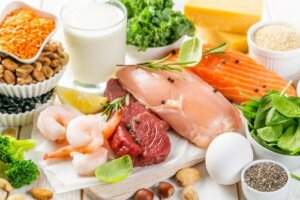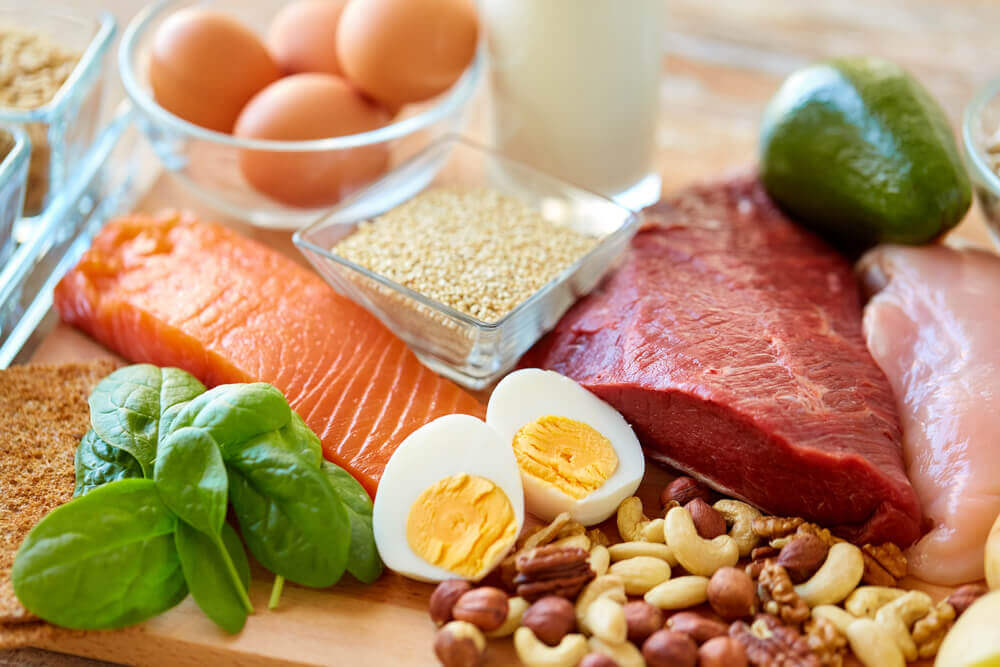Types of Proteins and Their Functions


Written and verified by the nutritionist Saúl Sánchez Arias
Do you know all about the different types of proteins? Protein is an essential macronutrient for human beings. It must be present in the diet and is made up of smaller elements called amino acids.
Among all the amino acids that make up a protein we find the non-essential ones (they can be synthesized by the body itself) and the essential ones (which must be ingested through food).
Thus, we can affirm that regular protein intake is indispensable for life. The most recent scientific articles state that consuming this nutrient can prevent certain diseases, such as sarcopenia, from developing. However, there are several types of proteins according to their origin and function.
Types of proteins: Two possible origins
We can distinguish between proteins of animal and vegetable origin. The former are characterized by having a higher quality than the latter. They’re called proteins of high biological value, since they contain the nine amino acids that are essential for any human being in their composition.
In addition, they have the property of being highly digestible, which facilitates their absorption and their use in the human metabolism. The most perfect protein known in the animal world is egg protein.
However, there are other proteins such as milk or meat proteins of very high quality. In fact, protein supplements are generally based on whey protein isolates that allow a high intake of this macronutrient. Their use is especially recommended in situations of intense exercise, according to research published in the journal Nutrients.

On the other hand, vegetable protein is usually incomplete. This means that it’s deficient in at least one essential amino acid. Therefore, we have to combine different types of vegetable proteins to achieve a correct amino acid intake.
However, even if we manage to optimize this intake, the digestibility of vegetable protein is much lower. This means that its absorption and bioavailability is lower than protein from the animal world. In balanced diets, specialists recommend that at least 50% of the protein intake comes from animal proteins.
Also read: Why Is Consuming Proteins So Important?
Functions of proteins
Protein is a macronutrient that has several functions within the body. One of the main ones, and for which they’re best known, is their structural capacity to build and repair bones, muscles, and other tissues. However, their functions go much further:
- They function as antibodies to defend us from foreign organisms.
- They’re enzymes that accelerate or enable physiological reactions that occur in the body.
- They allow internal pH balance by means of a buffering system.
- Help in muscle contraction.
- They give elasticity and resistance to organs and tissues.
- Help the correct functioning of the nervous system.
- Possible energy reservoir.
- They transport oxygen through the blood.
- Therefore, it’s clear that proteins can perform enzymatic, structural, defensive, storage, transport, receptor and motor functions.
Essential macronutrient
For all these reasons, protein is an essential macronutrient for human nutrition. Despite this, the protein load in today’s diet tends to be higher than recommended.
While specialists recommend doses of between 0.04 and 0.05 ounces (1.2 and 1.6 g ) of protein per 35 ounces (1 kg) of body weight for sedentary people, people reach values of around 0.07 ounces (2 g).
These values may make sense for strength or high-intensity athletes. This was stated in a study conducted in 2015. However, in sedentary adults, they could be putting too much stress on the liver and kidneys and don’t offer too many advantages in terms of body composition.

Thus, we recommend slightly reducing protein intake, except in cases of special needs. The combination of animal and vegetable proteins is usually a good choice in any diet. It’s interesting to choose foods from the vegetable kingdom with a high protein content, as is the case of nuts.
Another interesting option is legumes, but in this case specialists recommend combining them with cereals to correct the supply of essential amino acids.
Discover: How do Legumes Protect Against Type 2 Diabetes?
Include different types of protein in your diet
Protein, along with fats, are the macronutrients with the most functions in the body. For this reason, protein intake is essential within the framework of a varied diet. In spite of this, today’s society tends to over-consume protein, especially due to the sale of protein supplements. Before consuming this type of supplement, we suggest you consult a nutritionist to assess whether it’s necessary or not.
In any case, moderation and variety are the key concepts in the diet of any sedentary person. To reduce the consumption of meat and to increase the consumption of fish, as well as to introduce proteins coming from the vegetable world, are very healthy habits.
All cited sources were thoroughly reviewed by our team to ensure their quality, reliability, currency, and validity. The bibliography of this article was considered reliable and of academic or scientific accuracy.
- Ten Haaf DSM., Regt MF., Visser M., Witteman BJM., et al., Insufficient protein intakes is highly prevalent among physically active elderly. J Nutr Health Aging, 2018. 22 (9): 1112-1114.
- West DWD., Sawan SA., Mazzulla M., Williamson W., Moore DR., Whey protein supplementation enhances whole body protein metabolism and performance recovery after resistance exercise: a double blind crossover study. Nutrients, 2017.
- Spendlove J., Mitchell L., Gifford J., Hackett D., et al., Dietary intake of competitive bodybuilders. Sports Med, 2015. 45 (7): 1041-63.
This text is provided for informational purposes only and does not replace consultation with a professional. If in doubt, consult your specialist.








